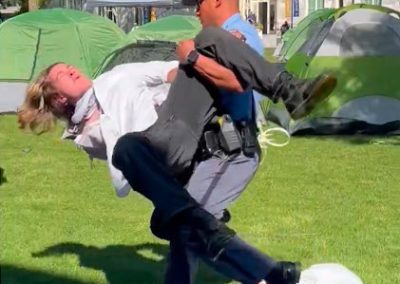When Brian Dalton was attacked his body’s instinctive survival system by-passed his thinking brain and deployed human nature’s airbag: the Startle-flinch response. IMO it helped save his life.
The startle-flinch response deploys like a biological airbag, expanding in a sudden incident to create space between you and the danger.
In Brian’s fight, the flinch-response expanded as nature designed it. It bought him time, created space between him and the threat and this allowed his mind to catch-up to what was happening and ultimately get to his sidearm.
Watch this short video. Then, if you want to learn more about how the flinch can play a role in your safety, continue reading the article.
Physiology vs. Physicality
The human brain and neuroscience can play a huge role in your training and subsequently your safety. As a police officer you should learn more about how physiology, fear and physics can play a huge role in how you navigate violence.
When a violent stimulus is introduced too quickly the body’s survival system hijacks executive function. The typical psychological response is to protect the head and then push away danger. Fingers are splayed if the hands are empty and the forearms are outside ninety degrees from the elbow.
The startle-flinch is hardwired into you.

When our situational awareness is compromised we must rely on instinct, intuition, and psychology. Think of your startle-flinch response as the equivalent of your “backup” – it’s the back-up to your DT, your complex motor skills.
Letting Go Isn’t Easy
How many of you noticed the summons floating through the frame long after the attack?
Rewatch if you missed it.
Two key points: even though officer Dalton knew he was in a fight for his life, physiology had already intervened and was pushing away the danger. Dalton knew he had to get to his weapon as he was being stabbed, the whole time he was still holding the summons.
This is another vital element to understanding physiology and neuroscience. If you are holding something in your hands, your flinch-response via the crossed-extensors will cause you to tighten around that object. This is vital when seconds count. It could be the door frame of a suspect’s car, their clothing, your flashlight, or in this case the summons (again, watch it drop in slow motion long after the fight started).
Understanding why allows you to recognize it sooner and fix it.
I can’t emphasize how important this point is to your ‘future’ safety because in a future encounter you will have an object like your flashlight in your hand and it might be your dominant hand that you need to transition your weapon to. You may be pulling a suspect out of car when he launches an attack. You will flinch and your grip will tighten around whatever you’re holding. This will either delay or interfere with your next action.
Now that you understand this, intelligently build these ‘physiological malfunctions’ into training and you will improve your self-awareness and help convert the flinch sooner.

Violence Doesn’t Care
Sorry. It doesn’t.
In 1980 I began doing scenario-training. We would run scenario seminars monthly and about 7 years into this I observed how this weird but intuitive movement of pushing away the attacker seemed to mess up most attacks and interrupted the flow of the attacker. It was an ugly moment. But it often appeared out of nowhere. This movement of course is the ‘startle-flinch’ response.
Here was the next and more important observation: I noticed how ‘everyone‘ flinched regardless of their training, experience or background. WTF? After watching this for years I concluded that it was the stimulus (the aggression of the attack) that triggered the flinch and the skill of the defender wasn’t really a factor if the attack – stimuli- was sudden and close.
The big reframe was built around the ‘action vs reaction’ model:h
In law enforcement the phrase “Action is faster than reaction” is often used in training, but what is it’s point? How is this logic applied to officer survival research?
Consider this: If action is faster than reaction – which is accurate – well the bad-guy is ‘action’ in an ambush. That means the way many are training for violence isn’t congruent with math, psychics and psychology. This can get very deep, but the gist of it is that we need physiology to assist us during sudden attacks. Had Brian Dalton brought his support hand to his sternum as he did a close quarter draw, this fight might’ve had a very different outcome.
I began analyzing the startle-flinch and its potential role in personal defense response in the late 80’s and in 1988 wrote this thesis statement:
“What does your body do prior to any training? Does that movement have a protective response? If yes, then why aren’t we integrating this into all our training?”
In short: When a stimulus is introduced too quickly the human body flinches. This is a fact. Why not integrate an instinctive response into your training? It’ll make you safer.
Friends, I’ve been studying self-defense for over 50 years. I wrestled, boxed, studied many martial arts and after one of my students lost a fight I thought I had prepared him for, I switched my entire approach to only looking at violence through the eyes of the predator. This challenged so many assumptions about how we should train. It spawned an entire reframe for me and my students. It forced me to look deeper into psychology and neuroscience. I spent decades researching this trying to figure out a reliable system that could make anyone safer sooner.
After 30+ years of studying violence, I submit this to you: If you have the choice, you will always want back-up. The ‘startle-flinch’ is your body’s biological backup system. Learn to weaponize your startle flinch now, because when sudden violence erupts, it’s what’s going to be what’s between you and the bad-guy.
Stay safe,
Coach Blauer
Want to get safer sooner?
Additional reading and resources:
I encourage you all reading this to check out presumed compliance as well, as its PC that does impact perception speed and reaction time.
The goal in true scenario-based training is to find the balance between primal-gross motor responses and complex motor skills and that has been my mission and journey and has resulted in a method to weaponize the startle flinch. Host a course. hosting@blauertactical.com
DID YOU KNOW? A police agency in the UK conducted a 5-year independent study about our method? This agency reported a 41% reduction in head trauma, a 29% reduction in ‘use of force’ complaints and hundreds of thousands of dollars saved as a result. If you would like a copy of this report and more information about the SPEAR System email us from your government email address. ask@blauertactical.com
Here is the link to the original video posted by Calibre Press: https://calibrepress.com/2019/07/video-officer-stabbed-with-screwdriver/











0 Comments